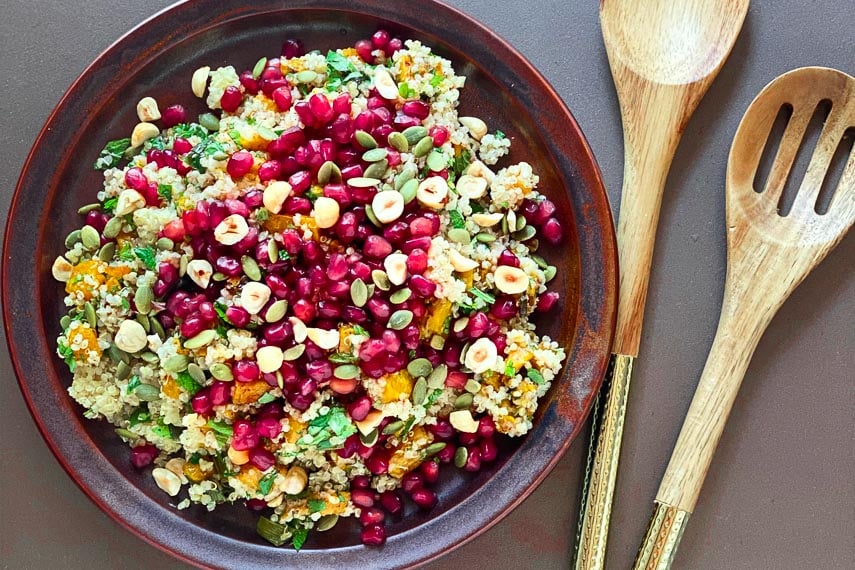A lot of research has been placed on the role of various bacteria in irritable bowel syndrome (IBS). However, a less understood but perhaps equally important area of investigation and understanding is in the fungal populations in the gut that may play a role in the symptoms of IBS such as gut-brain interactions, immune-mediated reactions and visceral hypersensitivity.
If you’ve been curious about how yeast and other types of fungi may play a role in your symptoms, let’s dive in for a closer look.

What Is The Mycobiome?
Fungi are a group of microorganisms, that can occur as yeasts, molds or a combination of both forms. Yeasts are a type of microscopic fungi that consist of single cells that reproduce by budding.
Fungi play an important role in maintaining homeostasis in the gut microbiome, however some types of fungi are capable of causing various types of diseases. Like bacteria in our gut, the balance and types of fungi are important to overall health.
The gut mycobiome is the collection of intestinal fungi and their collective genome (aka genetic material. The mycobiome lives in not only our gastrointestinal tract, but also on our skin, in our respiratory tract, genital and urinary tracts and other mucous systems in our body.
Research shows that fungi constitute no more than 0.1% of the human gut microbiota. This small population explains why little attention has been given to these microbes, however we are learning more and more about how they may play a role in GI symptoms and conditions.
The Mycobiome & IBS

Most information around IBS and the microbiome is about bacteria, however these are not the only microbes in your gastrointestinal tract that may be impacting your symptoms.
Those most common species in the mycobiome include Sachromyces cerivisae and Candidas Albicans, Those with IBS may have higher levels of candidas albicans according to more recent research.
The mycobiome may be important because the yeast species are involved in fermentation of carbohydrates. As we know, the low FODMAP diet attempts to reduce fermentation by microbes in the gut, and this has been focused on bacteria in the small and large bowel breaking down higher FODMAP carbohydrates.
In a 2017 study, an analysis of patients with IBS and controls was done which found an association between fungal dysbiosis with IBS. In studies of rats, the researchers found fungi promoted visceral hypersensitivity. They suggested that the intestinal mycobiome might could be manipulated for treatment of IBS-related visceral hypersensitivity, however more high quality research is needed.

In another study, the fecal mycobiota of healthy volunteers and patients with IBS with known visceral sensitivity status were compared. Patient samples showed lower diversity and a difference in mycobiome signature when comparing “normosensitive” and hypersensitive patients. Mycobiota dissimilarities between controls and IBS patients were later confirmed by others.
The connection is not exactly clear, but a 2019 review article suggested the pathogenesis of IBS may be connected to mycobiome dysfunction and contribute to the underlying symptom drivers of IBS including chronic low-grade inflammation, visceral hypersensitivity, and brain-gut interactions. Like the other studies suggest, more research is needed.

Image source: https://www.ncbi.nlm.nih.gov/pmc/articles/PMC6712173/ “The potential role of gut mycobiome in the pathogenesis of irritable bowel syndrome. Gut mycobiome is involved in the existing mechanisms of irritable bowel syndrome including low-grade inflammation, intestinal dysbiosis, visceral hypersensitivity, and brain-gut interactions.”
Small Intestinal Fungal Overgrowth (SIFO)
What is SIFO?
What happens when there is an overgrowth of fungi? Small intestinal fungal overgrowth (SIFO) is characterized by the presence of an excess amount number of fungal organisms in the small intestine. The most common symptoms of SIFO include belching, bloating, indigestion, nausea, diarrhea, and gas.
Historically, Candidiasis, a fungal infection caused by the overgrowth of candida, has only been seen to cause digestive symptoms in immunocompromised patients. However, newer research has shown that an overgrowth of fungi in the small intestine in non-immunocompromised subjects may cause unexplained gastrointestinal (GI) symptoms. Two recent studies showed that approximately one-quarter of patients with unexplained GI symptoms had SIFO. While we don’t know for sure, some IBS cases could potentially be explained by fungal overgrowth in the small bowel.
How Do We Test for SIFO?

Currently, the only validated method to test for Candidiasis or SIFO is a small bowel aspirate which involves taking a biopsy from your duodenum, the first part of the small intestine and culturing it in a lab. Small bowel aspirates are sometimes also used to diagnose SIBO or Small Intestinal Bacterial Overgrowth, however breath tests are more commonly used for SIBO as this procedure is quite invasive and is usually done during a routine endoscopy or gastroscopy.
Please take NOTE: there are many “home microbiome test kits” that claim to diagnose a yeast/fungal/ candida overgrowth. These have limited research behind them and are not a validated method of testing, and we highly caution you against using them. Further, some resources and online content have suggested a “Spit Test” which involves spitting into a glass of water and seeing how your spit (saliva) reacts and changes shape in the glass. We also recommend against this method of self-diagnosis and “testing” as well.
How Do We Treat SIFO?
It’s treated by using an antifungal drug known as Flucanazole. Some studies have shown that Henna plant, common Purslane, Oregano or Berberine may have antifungal properties, however this is not yet considered a validated method of treating fungal overgrowth.
Fungal Probiotics For IBS & Digestive Conditions
Have you taken a probiotic to help with your IBS and symptoms? Like many in our community, you’ve probably tried at least one in the past. Many assume that probiotics are bacteria based, but there are a few fungal strains with strong evidence to support their role in IBS and digestive conditions.
The World Gastroenterology Organization (WGO), defines probiotics as live microorganisms that, when administered in adequate amounts, confer a health benefit on the host.

You may have heard or tried S. Boulardii? Saccharomyces boulardii (S. boulardii) is a commonly used yeast-based (fungal) probiotic that was first discovered in the 1920s. It has been reported to be effective in various gastrointestinal conditions including such as Clostridium difficile associated diarrhea, antibiotic associated diarrhea, inflammatory bowel disease (IBD), SIBO, as well as IBS. The mechanism is not exactly clear, but it is understood that in the intestinal tract, S. Boulardii play a role in defense against toxins and resist pathogenic microbes, support the lining of the intestinal barrier and support Short Chain Fatty Acid metabolism to maintain balance in gut functioning.
In a 2021 Systematic Review and Meta Analysis, two types of yeast-based probiotics showed significant reduction in abdominal pain in IBS: S. boulardii CNCMI- 745 and S. cerevisiae CNCM I-3856.
There is even newer evidence that suggests that certain yeast-based probiotics may be an effective way to reduce side effects of cancer therapies and support treatment for colon cancer.
There is a lot we still don’t know about the use of fungal therapies like yeast-based probiotics for certain symptoms and subtypes of IBS, but so far research has shown a few key strains including S. Boulardii and S. Cerevisiae may have beneficial effects in the IBS population.
What Can You Do?

While research is limited, here are some suggestions if you have or suspect an imbalance in your gut mycobiome and yeast/fungi population.
Talk to Your Medical Team
In the age of information overload and everyone online is an “expert”, you may be tempted to self diagnose yourself with a yeast overgrowth or fall prey to inaccurate testing like home tool tests. However, we encourage you to speak with a medical doctor in order to receive gold standard testing for yeast overgrowth and investigation into your symptoms. If you have been dealing with persistent symptoms such as bloating, pain, distention and irregular bowel movements, reach out to a specialist so you can receive a proper diagnosis and from there you can find a personalized plan. We also encourage you to seek support from a Registered Dietitian to help you create a personalized plan based on your medical needs. Check out our Global Dietitian Directory here.
Consider a Probiotic Trial
Not all probiotics are created equal, so if you are looking to achieve a certain health benefit such as managing constipation, reducing bloating or preventing traveler’s diarrhea, you have to do your research first. We want to ensure the probiotic strain(s) in the product and how they work together (i.e. their synergistic effects) have proven benefits evidenced by clinical trials (and even better…systematic reviews & meta-analyses).
As there has been shown to be support for S. Boulardii and some other yeast based probiotics, you may want to give one a trial to see if it helps with your symptoms. When starting a probiotic, it is recommended to allow 4 weeks to assess any improvements. This is because symptoms sometimes get a little “worse” before they get better, so it’s important to let your microbiome adjust.
We always recommend speaking with your Registered Dietitian and/or Gastroenterologist to ensure that a probiotic product is right for your specific goals and needs before starting one.
You may want to also read: IBS & Probiotics: Should I Take Them?
The Low FODMAP Diet

At the time of writing this, a search of current research yielded no studies around the low FODMAP diet and yeast/fungi overgrowth or the microbiome. We can only suggest that a trial of low FODMAP may be helpful under the guidance of a Dietitian to see if it helps improve your symptoms.
You may want to also read: How Does the Low FODMAP Diet Affect the Gut Microbiome?
The Mediterranean Diet
A recent review suggests that the Mediterranean diet is a useful dietary pattern for functional gut disorders such as IBS, and that this dietary pattern may be helpful for modifying the gut mycobiome to aid in management of this condition.
The Mediterranean diet is based on a set of principles that include prioritizing plant-based and local foods. There is an emphasis on unsaturated fats from olive oil and nuts and fiber from various plant foods such as fruits and vegetables, nuts, whole grains, and legumes. Many of the foods are also considered low-glycemic, and as a whole, the diet places emphasis on higher fiber carb sources, and lower saturated and processed fats. Poultry, fish and meats are included, but more sparingly.
Again, while research is lacking in this area, shifting your diet towards a more plant forward and whole foods based diet would be a positive, so it’s also worth a trial and exploring if you have or suspect an imbalance in your mycobiome. Again, doing this in a structured manner, along with a dietitian, is recommended.
Support a Healthy Gut Microbiome

The gut microbiome consists of trillions of living microbes in your gut (AKA your digestive tract – all the way from your mouth until your anal canal). The microbiota inhabiting our gut not only include yeast and bacteria, but also protozoa, viruses, and archaea. These microbes should live together in harmony, and so supporting a healthy balance is key to overall digestive health and the mycobiome community!
Here are the basics for supporting a healthy gut microbiome:
- Fiber:
- Sources: nuts, seeds, legumes, vegetables, fruits, whole grains.
- Indigestible carbohydrates found only in plant foods that aid in digestive health, promotes fullness, and aids in waste elimination.
- Recommendations: 25g/day for females, 35g/day for males.
- Tips: Choose whole grains, plant-based meals, fruits for snacks, and make half your plate veggies.
- Plant-Based Proteins:
- Polyphenols:
- Antioxidants that promote beneficial bacteria and lower inflammation.
- Sources: beans, berries, dark leafy greens, dark purple fruits/veggies, green tea, dark chocolate, nuts.
- Tips: Add blueberries to cereal, “eat the rainbow” and include leafy greens in smoothies.
- Prebiotic Foods:
- Non-digestible fiber that functions as a fuel source for gut microbes.
- Sources: dark chocolate, jicama, lentils/chickpeas, artichokes, oats, seaweed, nuts.
- Tips: Snack on seaweed or nuts, add oats to smoothies.
- Resistant Starches:
- A type of prebiotic that is not digested in the small intestine fuel and acts as a fuel for gut bacteria.
- Sources: cooked/cooled potatoes, rice, quinoa, pasta, green banana flour, beans, plantains.
- Tips: Batch cook rice and potatoes, add 2 tablespoons canned, drained black beans to meals, and try overnight oats.
- Managing Stress:
- Cortisol and stress impacts microbiome populations and gut motility.
- Tips: Ensure quality sleep, daily self-care, regular movement, set boundaries, and support your vagus nerve.
- Sleep Hygiene:
- Sleep quality impacts gut microbiome diversity and gut motility, as well as helps to regulate stress.
- Tips: Maintain a consistent sleep schedule and good sleep hygiene.
You may also want to read: The Microbiome Explained.
The Takeaway

In conclusion, the mycobiome, though a relatively small and lesser understood component of the gut microbiome, plays a potentially significant role in the symptoms and management of IBS. Growing research indicates that fungal populations, particularly species like Candida albicans, may influence your gut health through mechanisms such as fermentation of carbohydrates, visceral hypersensitivity, and interactions with your immune system.
While most of our focus has been on bacterial balance in managing IBS, we need to acknowledge that the impact of fungal populations may have a bigger role than once thought. This provides an interesting area of research and potential treatments for IBS in the future!
Summary:
- What is the Mycobiome: Fungi, including yeasts, are a crucial but less understood part of the gut microbiome. Fungi constitute a small portion (0.1%) of the gut microbiota but can affect IBS symptoms.
- Fungi & IBS: Fungi like Candida albicans and Saccharomyces cerevisiae can impact gut health through fermentation, visceral hypersensitivity, and immune reactions. Higher levels of Candida albicans have been found in IBS patients in some studies. Fungal dysbiosis may potentially be linked to IBS symptoms.
- Testing & Treatment: A small bowel aspirate is the gold standard for diagnosing Small Intestinal Fungal Overgrowth (SIFO), not home stool tests or the “spit test”. Yeast-based probiotics such as Saccharomyces boulardii show promise in reducing IBS symptoms like bloating, pain and distention.
- Dietary Considerations: Low FODMAP and Mediterranean diets may help manage IBS and support a healthy mycobiome, although there is more that needs to be understood. Focusing on supporting the overall microbiome through diet and lifestyle changes may help.
- The Research Landscape: More studies are needed to fully understand and target the mycobiome in IBS treatment.





